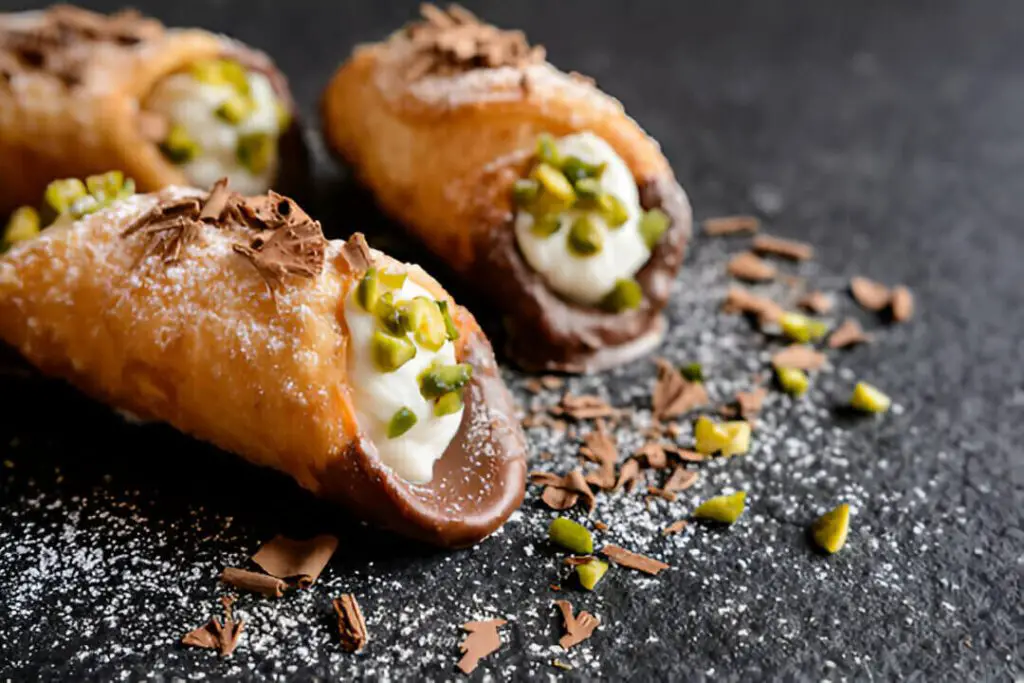Have you ever found yourself drooling over those crispy, cream-filled tubes of deliciousness at your local Italian bakery? You know, the ones dusted with powdery sugar that seem to call your name from the display case. If you’ve been too intimidated to actually order a cannoli and experience it for yourself, you’re seriously missing out!
Those tempting little pastries may look unassuming, but hiding inside their crispy shells is a luscious filling that’ll have you questioning why you waited so long to take a bite. A true taste of Italy, cannolis strike the perfect balance of sweet and savory flavors that make them utterly addictive.
So what does cannoli taste like, and what exactly is this magical combination that makes cannolis so irresistible? Is the filling as creamy and rich as it looks? Does the shell shatter into buttery flakes with each bite? I’m going to let you in on the secrets that’ll turn you into a full-blown cannoli fanatic. So get ready to have your taste buds transported straight to the streets of Sicily!
What Does Cannoli Taste Like?
When you take that first bite of a freshly filled cannoli, your senses are delighted by a harmonious medley of tastes and textures. The flavors are at once rich and delicate, familiar yet distinctive.
The defining taste is the luscious ricotta filling. Made from fresh ricotta cheese, it has a unique dairy flavor that’s slightly sweet with a hint of tanginess. The ricotta is blended with sugar, highlighting its natural creaminess without being cloyingly sweet. Depending on the recipe, you may detect delicate notes of vanilla, cinnamon, or bright citrus from lemon or orange zest folded into the velvet-smooth filling.
As your teeth sink through the lush ricotta, you encounter the crisp, shattering shell. The dough is made with flour, eggs, sugar, and butter, yielding a pastry that’s sweetly indulgent yet balanced. Often, the shells contain a splash of marsala wine, providing a subtle winey depth and tenderizing the crumb. Each bite delivers a delightful contrast between the tender, melt-in-your-mouth filling and the delicately crisp, flaky exterior.
The textural interplay adds another layer of decadence. The thick, velvety ricotta gives way to the light crunch of the shell in an utterly satisfying way. Every constituent plays its part in creating cannoli’s singularly lush yet uncomplicated flavor profile.
Some variations take the taste experience even further. Chocolate chips, candied fruits or nuts can be folded into the filling for pops of sweetness and crunch. The shells themselves may be dipped in melted chocolate or rolled in chopped pistachios before frying for a deeper richness.
Cannoli Filling
At the heart of every cannoli is the luscious, creamy filling that makes this Italian pastry so unforgettable. While the ingredients are relatively simple, the resulting taste is richly complex and deeply satisfying.
The star of the filling is ricotta cheese, a fresh, soft cheese with a slightly grainy texture. Ricotta has a mild, subtly sweet dairy flavor that serves as the perfect canvas for the other ingredients. Some bakers prefer to use the even richer mascarpone cheese instead for an ultra-luxurious filling.
Whichever cheese is used, it gets blended with plenty of granulated sugar to achieve that signature sweet creaminess. The amount of sugar is carefully balanced to avoid making the filling cloying or one-dimensional. You want the dairy flavor to shine through the sweetness.
Beyond the cheese and sugar base, other ingredients get folded in to heighten the flavors. Vanilla extract is very common, adding aromatic warmth and flower notes that complement the dairy notes beautifully. For an extra layer of fragrance, bakers will often incorporate citrus zest like lemon or orange into the mixture as well. The zest imparts enticing bright pops amidst the rich filling.
Many recipes also call for a heavy pinch of cinnamon to add further warmth and spice. While the cinnamon doesn’t overwhelm, it adds just enough pungency to cut through the velvety richness. A touch of almond extract can serve a similar purpose by contributing a delicate nuttiness.
Texture is also key for cannoli filling. It gets whipped to an incredibly smooth, lush consistency – almost like a thick pudding. As you bite into a cannoli, the filling should melt across your tongue with zero grittiness. Yet it needs to hold its shape enough to be piped smoothly into the crispy shells without being runny.
For an even more sublime filling, some bakers will fold in a bit of heavy cream, sweetened ricotta, or even mascarpone cheese. This enhances the creamy, velour-like mouthfeel while avoiding any hint of denseness. Other tasty mix-ins include finely chopped chocolate, candied citrus, or toasted nuts to add pockets of crunch and bursts of complementary flavor.
The Cannoli Shell

More than just a crispy vehicle for the creamy interior, a well-made cannoli shell offers textural contrasts and nuanced flavors that accentuate the filling’s richness.
The foundation is a basic pastry dough made from flour, sugar, eggs, and butter or vegetable oil. This simple mixture gets rolled out incredibly thin—paperlike in some cases—to achieve a delicate crispness once fried. An expert cannoli maker has the dough so thin you can practically see through it before cooking.
Keeping the dough at this precise thinness is essential. Too thick, and the shell turns out doughy or bready instead of shattering into enticing flakes. Too thin, and it risks becoming overly fragile or greasy. It’s a delicate balance that takes practice to nail.
Once the dough is stretched into translucent sheets, it gets wrapped around metal tubular forms and deep fried to transform the flat sheets into the signature cylindrical cannoli shapes. Frying at the perfect temperature (typically around 360°F) is crucial for crisping the shells evenly without burning the delicate dough.
In Sicilian tradition, many cannoli makers add a splash of fortified Marsala wine to the dough before frying. The wine adds deeper color to the shells, giving them an alluring eggy-gold hue. More importantly, it contributes warm, raisiny notelayered with appealing bitterness to balance the pastry’s richness.
As the hot oil envelops the dough cylinders, the transformation is almost alchemical. The exterior takes on an audibly crisp, flaky texture that provides a satisfying shatter with each bite. But the interior remains slightly softer and layered – a creamy contrast to the shattering shell.
Once cooled, the iconic tube shape gets filled with the lush ricotta filling via a filling tube or piping bag. The textures and flavors harmonize in each blissful mouthful. The richness of the cool, dense filling melds with the warmth and crunch of the wine-scented shell. You get creamy and crispy, sweet and slightly savory, in an ambrosial combination.
To add even more flavors and textures, some cannoli shells get coated in sheaths of finely chopped pistachios, candied fruit, or chocolate before frying. These crunchy coatings adhere beautifully during the frying process, creating crispy little pops and chewy bites that punctuate the cannoli’s main flavors.
Popular Flavor Variations

While the classic cannoli combination of sweet ricotta filling and crisp fried pastry shell is utterly irresistible on its own, creative bakers have dreamed up endless flavor riffs on this beloved Italian treat. By incorporating different mix-ins, extracts, and coatings, they’ve managed to heighten and accent cannoli’s fundamental flavors in uniquely delicious ways.
One of the most popular filling variations is to fold in chocolate chips, shavings, or a light chocolate cream. The slightly bitter, deeply rich cocoa notes make the perfect foil for the creamy, mild ricotta base. It adds decadent pockets of chocolate intensity without overwhelming the filling’s essential diary flavors. Some versions get even more indulgent by incorporating grated bittersweet or white chocolate directly into the ricotta mixture itself.
Along similar lines, chopped candied citrus, like orange or lemon, can enliven the filling with zesty bursts of bright fruitiness. The tangy, concentrated citrus flavors cut through the richness beautifully while complementing any added vanilla or cinnamon notes. Finely diced maraschino cherries make a colorful, booze-tinged addition as well.
Nuts are another beloved mix-in, with crunchy pistachios being one of the most popular choices. Their jade hue adds eye-catching contrast, while their toasted, buttery flavors and firm textures balance the soft, yielding ricotta. Other nuts, like almonds, hazelnuts, or walnuts, can get folded into the filling as well for their distinctly earthy, somewhat astringent flavors.
For those who lean toward bold spices, a sprinkle of aromatic cinnamon or pumpkin pie spice can imbue the filling with warmth and seasonal flair. A touch of coffee or espresso powder enhances the deeper dairy notes. And for an unexpected floral twist, culinary rose or orange blossom water provides delicate perfume notes.
On the shell side, chocolatey coatings can take the humble fried dough over the top. Some get simply rolled in a dusting of cocoa powder for a lusciously bitter crunch. More decadent versions get fully dipped in melted tempered chocolate and allowed to set into a snappy, enrobing shell that shatters with each bite. Chopped nuts, from almonds to pistachios, also make for stellar crunchy coatings.
Other flavor-packed coatings include a light showering of fragrant lemon or orange zest over the still-warm shells for a vibrant citrus aroma. Or a shellacking of honey creates a stickily sweet, richly floral crust. Some bakeries have even experimented with savory cannoli flavors by coating the shells in parmesan cheese, sundried tomatoes or herbs before frying.
FAQs
Does a cannoli taste similar to a cream horn or eclair?
While all three are filled pastries, a cannoli has a distinct flavor profile from cream horns or eclairs. The fried pastry shell gives the cannoli a nice crisp texture and a slightly nutty, wine flavor from the marsala wine used in the dough. The ricotta filling also has a slightly tangy, fresh cheese flavor that differs from the thick custard or whipped cream in other pastries.
How sweet is the cannoli filling?
The sweetness level can vary between cannoli fillings, but in general, it is mildly to moderately sweet. The sugar in the ricotta mixture gets balanced out by the tanginess and richness of the fresh cheese, giving it a more delicate sweetness compared to something like a chocolate mousse filling. Any citrus zest or extracts also help cut through the sweetness.
Do cannoli taste better fresh or can I make them ahead?
For the absolute best flavor and texture, cannoli should be filled and eaten soon after the shells are fried. As the pastry shells sit, they lose their shatteringly crisp texture. And if the filling sits too long in the shells, it can cause sogginess. So while you can make components ahead, for peak cannoli bliss, eat them as fresh as possible.
Are cannoli very rich and decadent tasting?
Yes, with the egg-enriched fried pastry shell and creamy cheese-based filling, cannoli definitely lean towards the richer, more decadent end of the dessert spectrum. However, their small portion size prevents them from becoming overly heavy or cloying. The bright flavors and textures also provide great balance to the richness.
The Verdict
So, what does cannoli taste like? In a word: heavenly. With its perfect balance of sweet and savory flavors, creamy filling, and crispy shell, it’s no wonder these little Italian treats have captured the hearts (and taste buds) of people all over the world. Whether you’re enjoying a classic cannoli or trying out one of the many delicious variations, one thing’s for sure: once you take that first bite, you’ll be hooked for life.



